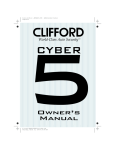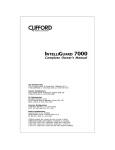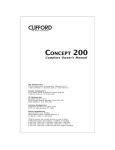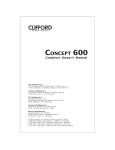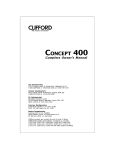Download Clifford concept 50x User's Manual
Transcript
World-Class Auto Security TM concept 50x Owner's Manual The Concept 50x is covered by one or more of the following Clifford Electronics U.S.A. patents: 4,158,874; 4,233,642; 4,327,444; 4,383,242; 4,430,685; 4,845,464; 4,887,064; 4,890,108; 4,922,224; 4,997,053; 5,081,667; 5,146,215; 5,157,375; 5,467,070 and other patents pending. Table of Contents Standard Features of the Concept 50x . . . . . . . . . . . . . . . Your 4-button/12-channel remote controls . . . . . . . . . . . . . How to use your keychain remote control . . . . . . . . . . . . . . What each button/channel does . . . . . . . . . . . . . . . . . . Anti-CodeGrabbing (ACG) with Random Code Encryption . . . . Smart prior intrusion attempt alert . . . . . . . . . . . . . . . . . . How to interpret the chirps and indicator light flashes . . . . . . . How to interpret the LED status indicator . . . . . . . . . . . . . . AutoArming . . . . . . . . . . . . . . . . . . . . . . . . . . . . . . AutoArming enable/disable . . . . . . . . . . . . . . . . . . . . . Visual acknowledgment . . . . . . . . . . . . . . . . . . . . . . . AutoArm & Lock . . . . . . . . . . . . . . . . . . . . . . . . . . . . Instant AutoArming bypass . . . . . . . . . . . . . . . . . . . . . . UltraSecure coded valet mode . . . . . . . . . . . . . . . . . . . Definitions . . . . . . . . . . . . . . . . . . . . . . . . . . . . . . . To enable valet mode . . . . . . . . . . . . . . . . . . . . . . . . . To exit valet mode . . . . . . . . . . . . . . . . . . . . . . . . . . . Setting your own secret valet code . . . . . . . . . . . . . . . . . Keyless entry in valet mode . . . . . . . . . . . . . . . . . . . . . Remote controlled valet mode entry and exit . . . . . . . . . . . Remote controlled sensor adjustment . . . . . . . . . . . . . . . . Remote controlled override of one or both sensor zones . . . . . Built-In Two-Point AutoImmobilizer . . . . . . . . . . . . . . . . . . Smart AutoTesting . . . . . . . . . . . . . . . . . . . . . . . . . . . Specific malfunction identification . . . . . . . . . . . . . . . . . . Automatic malfunction bypass . . . . . . . . . . . . . . . . . . . Multiple-event TotalRecall . . . . . . . . . . . . . . . . . . . . . . AutoLock and AutoUnLock . . . . . . . . . . . . . . . . . . . . . . False Alarm Prevention and FACT — False Alarm Control and Test SmartPowerUp II . . . . . . . . . . . . . . . . . . . . . . . . . . . . Smart Self-Powered Siren with Digital ComLink . . . . . . . . . . . Unbreachable Digital ComLink . . . . . . . . . . . . . . . . . . . . Smart-charging . . . . . . . . . . . . . . . . . . . . . . . . . . . . Personalized Siren Sounds . . . . . . . . . . . . . . . . . . . . . . Long-term chirp silencing . . . . . . . . . . . . . . . . . . . . . . . Remote controlled chirp muting . . . . . . . . . . . . . . . . . . . QuietChirps (muffled chirp sound level) . . . . . . . . . . . . . . . Automatic low battery warning . . . . . . . . . . . . . . . . . . . . Noise abatement circuitry . . . . . . . . . . . . . . . . . . . . . . User-selectable features . . . . . . . . . . . . . . . . . . . . . . . Step-by-step programming instructions . . . . . . . . . . . . . . Adding new remote controls . . . . . . . . . . . . . . . . . . . . . How to erase the codes of lost or stolen remote controls . . . . . Table of user-selectable features . . . . . . . . . . . . . . . . . . 1 . . . . . . . . 2 . . . . . . . . 6 . . . . . . . . . 6 . . . . . . . . . 7 . . . . . . . . 8 . . . . . . . . 8 . . . . . . . . 9 . . . . . . . . 9 . . . . . . . . 9 . . . . . . . . . 9 . . . . . . . . . 9 . . . . . . . . . 9 . . . . . . . . . 9 . . . . . . . 10 . . . . . . . . 10 . . . . . . . . 10 . . . . . . . . 11 . . . . . . . . 11 . . . . . . . . 11 . . . . . . . . 12 . . . . . . . 12 . . . . . . . 12 . . . . . . . 13 . . . . . . . 13 . . . . . . . . 13 . . . . . . . 14 . . . . . . . 14 . . . . . . . 14 . . . . . . . 14 . . . . . . . 14 . . . . . . . 15 . . . . . . . . 15 . . . . . . . . 15 . . . . . . . . 15 . . . . . . . . 15 . . . . . . . . 15 . . . . . . . . 15 . . . . . . . . 15 . . . . . . . . 15 . . . . . . . 16 . . . . . . . 16 . . . . . . . 18 . . . . . . . 18 . . . . . . 19-20 Standard Features of the Concept 50x ✔ Lifetime Warranty — For as long as you own the vehicle, Clifford will repair or replace the control unit and remote controls free of charge (see warranty card for full details). — One of many patented Clifford innovations, FACT absolutely, positively ends recurring false alarms. ✔ FACT — False Alarm Control and Test ✔ A Pair of 4-Button/12-Channel Remote Controls — Fingertip command from a distance. ✔ Anti-CodeGrabbing (ACG) with Random Code Encryption — Today’s criminals are shifting from code scanning to a new, much more efficient method of electronic thievery: “code-grabbing.” When you use a car alarm remote control, it transmits a digital code to your alarm. A thief with a code-grabber can record that code right off the air from hundreds of meters away, then play it back when you’re gone to disarm the alarm and unlock the doors. Within seconds, your car is just another theft statistic. Fortunately, Clifford’s Anti-CodeGrabbing (ACG) randomly changes the transmitted code every time you press any of the remote control buttons. And since these codes are selected by the system’s microprocessor from an electronic file containing several trillion codes, the remote control NEVER sends the same code twice, and the system control unit NEVER accepts the same code twice. That makes code-grabbing utterly useless against the Clifford Concept 50x. ✔ UltraSecure Coded Valet Mode™ — Ensures that no thief can turn off your Concept 50x like they can all other brands of alarms. Remote Controlled Valet Mode Entry and Exit — With just a press of a button on your remote control, you can enter or exit valet mode. Indicator light flashes visually confirm valet mode entry and exit. — For the utmost in theft prevention, two AutoImmobilization circuits interrupt both the starter and electronic fuel pump while the system is armed. Even if a thief were to pull the fuses or cut all the wires, the starter and fuel pump remain immobilized. ✔ Built-In Two-Point AutoImmobilizer Failure-Proof Driving Safety — Even in the unlikely event of a system malfunction, the AutoImmobilizer will not stop the engine while the vehicle is being driven. 2 Standard Features of the Concept 50x (cont.) ✔ Remotely Adjustable Dual-Zone Proximity Sensor— Two sensor zones provide full protection: If someone is lurking near your car, the system will sound a warning tone. But if a thief actually leans into the passenger compartment, the system will instantly blast the siren. It is impervious to wind and temperature variations that cause ultrasonic sensors to false alarm and you can even adjust sensitivity of each zone via the remote control! ✔ Dual-Mode “Chirp” Silencing —Whenever you wish, just a press on the remote control will arm and disarm the system silently. It’s perfect when parking at night in a quiet residential area. Or, if you prefer, you can turn off the chirps on a long-term basis until you wish to turn them back on. ✔ Remote Door Locking/Unlocking with Built-in Relays — No more fumbling with keys in the dark or bad weather! A press of a button on the remote simultaneously arms your system and locks the doors. Another press disarms and unlocks. User-Selectable AutoLock — Automatically locks the doors the instant you turn on the ignition to start the engine. User-Selectable AutoUnLock — Automatically unlocks the doors when you turn off the engine. — Continuous two-way digital communication between the system and the siren assures that if, at any time, the system fuse is pulled or any siren wire is cut, the siren will instantly activate for five minutes. Yet when the system is disarmed and power is interrupted, the siren will remain silent. ✔ Smart Self-Powered Siren with Unbreachable Digital ComLink Personalized Siren Sounds: You may select any combination of 6 different sound patterns for unmistakable recognition from a distance. So if you hear a siren at a distance, you will know for sure whether or not it is your car. Automatic Low Battery Warning: If at any time the siren’s back-up battery voltage is low or it fails to hold its charge, the normal arm and disarm chirps will be muted to alert you of the problem. Once the siren’s internal back-up battery is charged, the chirps will automatically be restored. ✔ Smart Remote Trunk Release Capability — Assures the optional remote trunk release can be activated only if the system is disarmed. It also makes sure that the trunk release cannot be remotely activated while driving. 3 Standard Features of the Concept 50x (cont.) — On certain vehicles (including several models of Mercedes Benz, Jaguar, Volkswagen and BMW), the system’s integrated timer and an optional relay can be used to automatically close the power windows and sunroof every time you remotely arm your system. ✔ Remote Window/Sunroof Closure Capability ✔ QuietChirp— Whenever you desire, you may choose to lower the decibel volume of the arm and disarm chirps to a level that is clearly audible but less obtrusive than the full-volume chirps. All it takes is a few flicks of a switch. ✔ User-Selectable AutoArming— Automatically arms itself “passively” if you forget and has all these additional features: AutoArming Enable/Disable — You may disable or re-enable the AutoArming feature with just a few flicks of a switch. AutoArm & Lock — You may set the system to automatically lock the doors every time the system AutoArms. Visual Indication — Two parking lights flashes signal that the 30-second countdown to AutoArming has started. Instant AutoArm Bypass — Just a quick turn of the ignition switch will bypass AutoArming for one cycle — perfect when fueling the vehicle. AutoArming is automatically restored the next time you park. ✔ Patented Smart Prior Intrusion Attempt Alert — When you return to your vehicle and remotely disarm your Concept 50x, a special chirp and indicator light flash sequence will audibly and visually alert you from a distance if an intrusion attempt was foiled while you were away. Your Concept 50x will even identify the specific trigger or sensor that detected the intrusion attempt. ✔ Remote Controlled Courtesy Lighting — For your personal safety and convenience, when you remotely disarm your Concept 50x, the interior lights turn on and stay on until you start the engine or 30 seconds, whichever occurs first. — On-board relay and circuitry will visually confirm door lock and system status. ✔ Built-In Indicator Light Flasher 4 Standard Features of the Concept 50x (cont.) ✔ Patented Smart AutoTesting— Automatically tests all system triggers and sensors every time you remotely arm and warns you if you accidentally arm your Concept 50x system with the hood or trunk open. If there is a genuine trigger or sensor malfunction, the system will specifically identify the problem, thereby eliminating time-consuming and costly trouble-shooting. ✔ Patented Malfunction AutoBypass with Automatic Monitoring — In the unlikely event of a trigger or sensor malfunction, Concept 50x automatically bypasses the malfunction and arms all other points to continue relentless protection of your vehicle. If you simply left the hood, trunk or a door open when you armed, just close it and the system will again monitor that trigger point. ✔ Multiple-Event TotalRecall— Concept 50x’s memory stores the identity of the last eight trigger and sensor activations. This provides an invaluable diagnostic means, since, whenever you wish, the system will visually identify the activated triggers and sensors in reverse chronological order. — Just a few flicks of a switch lets you match to the system up to 4 different 12-channel Clifford ACG remote controls. Just as easily, a lost or stolen remote control can be deleted. ✔ Patented Remote Control Code Learning with MultiRemote Recognition ✔ Multiple-Car Control — You may use the same remote to control Concept 50x systems on up to six of your other vehicles. ✔ High-Luminescence LED Status Indicator — Adds visual deterrence and identifies system status. ✔ Patented SmartPowerUp II — When power to the system is disconnected, the system’s non-volatile memory always remembers the security system’s last state (armed or disarmed) and returns to that state when power is restored. So if a thief disconnects the power and then restores it in an attempt to start the car, the system will instantly re-arm. 5 Your 4-button/12-channel remote controls The 4-button/12-channel remote controls are ultra-sophisticated miniature radio transmitters powered by a tiny 12-volt battery. Range is up to 30 meters. A weak remote control battery will reduce range. Electrical interference and even sunspots can interrupt the signal from your remote control to the system. If this happens, repeatedly press the remote control button (this works better than holding the button down). The 4-button/12-channel remote control is the key to your system. It has Clifford’s Anti-CodeGrabbing (ACG) technology for the ultimate protection against “code-grabbing” devices (see page 8). You will use your remote to arm and disarm the system, lock and unlock the doors, enter and exit valet mode, engage and disengage the AutoImmobilization circuits, and command options such as a remote trunk release, power window operation and even remote engine starting. How to use your keychain remote control Your remote control can individually command up to 12 different system functions and options. It’s like having a TV with 12 channels. You change channels (functions) with your keychain remote control. But instead of putting 12 buttons on the remote, we made it easy: First, the button you use the most — button 1 to arm, disarm, lock and unlock — is larger than the others. Buttons 2, 3 and 4 are the smaller buttons to the right, below and left of button 1. The LevelShift button on the side of the remote control allows you to select channels 5–12: To transmit either channel 1, 2, 3 or 4: Just press either button 1, 2, 3 or 4. For instance, to transmit channel 3, press button 3. While you transmit, the LED indicator will blink once every second: this indicates level 1. To transmit either channel 5, 6, 7 or 8: Press the LevelShift button once. This shifts buttons 1–4 to level 2 (channels 5–8). Then press the desired button within the next 7 seconds. For instance, to transmit channel 5, press the LevelShift button once, then press button 1. While you transmit, you’ll notice that the LED indicator blinks twice, pauses, blinks twice, etc.: this indicates level 2. To transmit channel 9, 10, 11 or 12: Press the LevelShift button twice. This shifts buttons 1–4 to level 3 (channels 9–12). Then press the corresponding button within the next 7 seconds. For instance, to transmit channel 10, press the LevelShift button twice, then press button 2. While you transmit, you’ll notice that the LED blinks three times, pauses, blinks three times, etc.: this indicates level 3. NOTE: One second after you stop transmitting level 2 or level 3 (channels 5–12), the remote control automatically returns to level 1 (channels 1–4). 6 What each button/channel does Your Concept 50x remote controls come pre-programmed so that certain channels command certain functions. If you wish, you can actually assign any channel to any function (see pages 16-20). The following chart indicates what each remote control channel number does, and how to transmit each channel number. Factory settings of the 12 remote control channels Transmitting channel number: Causes the system to: Press the How Press LevelShift many button button? times? number 1 arm or disarm and lock or unlock the doors no — 1 2 optionally turn on a timed device (if the system is armed) AND optionally pop the trunk (if the system is disarmed) no — 2 3 silently arm or disarm no — 3 4 activate an optional accessory no — 4 5 arm or disarm a Concept 50x on your second vehicle yes once 1 6 Command a Concept 50x on your second vehicle to optionally turn on a timed device (if the system is armed) AND optionally pop the trunk (if the system is disarmed) yes once 2 7 activate an optional accessory controlled by a Concept 50x on your second vehicle yes once 3 8 activate another optional accessory controlled by a Concept 50x on your second vehicle yes once 4 9 enter/exit valet mode yes twice 1 10 remotely turn off one or both sensor zones yes twice 2 11 activate an optional accessory controlled by a Concept 50x on your third vehicle yes twice 3 12 activate another optional accessory controlled by a Concept 50x on your third vehicle yes twice 4 TO ARM THE SYSTEM . . . . . . . Press button 1 (channel 1) once. You will hear two chirps and the indicator lights will flash twice. The dashboard LED will flash repeatedly and the car doors will automatically lock. TO DISARM THE SYSTEM . . . . . . . Press button 1 (channel 1) again. One chirp and one indicator light flash confirms disarming. In addition, the doors will automatically unlock and the interior lights will turn on and stay on for 30 seconds or until you start the engine, whichever occurs first. 7 TO SILENTLY ARM OR DISARM THE SYSTEM . . . . . . . Press button 3 (channel 3). Your Concept 50x system will arm or disarm with all the indications noted above except for the chirp acknowledgments. TO REMOTELY TURN ON A TIMED ACCESSORY . . . . . . Button 2 (channel 2) controls an electronic interlock that lets you separately command two functions with the same channel: one when the system is armed and another when disarmed. Pressing button 2 while the alarm is armed will activate the system’s timed accessory output for any duration you wish between one second and two minutes (the factory setting is 30 seconds; see User-selectable features on pages 16-20). TO REMOTELY OPEN THE TRUNK . . . Button 2 (channel 2) can control another function when the system is disarmed, such as an optional remote trunk release. Pressing button 2 while the alarm is disarmed will remotely open the trunk. TO ACTIVATE OTHER OPTIONS REGARDLESS OF ALARM STATE . . . . . . . Button 4 (channel 4) and channels 5–12 (see How to use your keychain remote control on page 6) can activate accessories such as the IntelliStart remote engine starter, remote power window control, Concept 50x systems and accessories on your other vehicles, etc. Anti-CodeGrabbing (ACG) with Random Code Encryption Protects you and your automobile from the most effective and onerous car stealing device ever used by car thieves — a code-grabber. Code-grabbers literally record, from hundreds of meters away, the code sent by your car alarm remote control. Then the thief simply plays back the code when you’re gone, instantly disarming the alarm and unlocking the doors. It’s like giving the thief your car keys. But not if you have the Concept 50x, since it utilizes complex digital signal processing and unbreachable encryption to randomly change the digital code every time you use the remote control. Your remote control will never transmit the same code twice, and the control unit will never accept the same code twice. Thus the code recorded and played back by the thief’s code-grabber will never be accepted by your Concept 50x. Smart prior intrusion attempt alert If you hear three chirps when you remotely disarm instead of the usual one chirp, it means that a trigger or sensor was activated in your absence. When you enter the vehicle and turn on the ignition (or start the engine), the LED will blink 1–6 times, pause, then repeat the blink cycle 4 more times. Count the number of blinks in one cycle and refer to the chart on page 13 to identify the trigger or sensor that was activated while you were away. 8 How to interpret the chirps and indicator light flashes When you use the remote, the system responds with chirps and indicator light flashes: Chirps and flashes Meaning 1 Your system is disarmed 2 Your system is armed 2 and then 4 Armed but there is a door open or the sensor is malfunctioning (see Smart AutoTesting on page 13) 3 Disarmed but there was an intrusion attempt while you were away (see Smart prior intrusion attempt on page 8) 4 Armed but the hood or trunk is ajar (see Smart AutoTesting on page 13) How to interpret the LED status indicator The LED on your car’s dashboard or console will inform you of the system status: LED Condition Meaning Off System is disarmed and in normal operating mode On Programming or valet mode. Flashing The AutoImmobilizer is engaged and/or the system is armed and protecting your vehicle Pause between flashes Either a malfunction (see page 13) or an intrusion was attempted (see page 8) AutoArming If this feature is enabled and you forget to remotely arm, the system will automatically arm itself 30 seconds after you park the vehicle, exit, and close all the vehicle doors. For your convenience, if you re-open any door(s) within the 30-second countdown, AutoArming will restart from the beginning once all doors are closed. Concept 50x has these additional AutoArming features: AutoArming enable/disable: If you prefer, you may deactivate or reactivate the AutoArming feature. See User-selectable features on pages 16-20. Visual acknowledgment: Five seconds after you exit the vehicle and close all the doors, the indicator lights will flash twice to confirm that the AutoArming countdown is progressing. Then, 25 seconds later, the system will AutoArm. AutoArm & Lock: To ensure you can’t accidentally lock your keys inside the car, the system is factory-set not to lock the doors upon AutoArming. To change this setting, see User-selectable features on pages 16-20. Instant AutoArming bypass: Prevents AutoArming when fueling the vehicle and other times when you wish to temporarily bypass AutoArming. To activate Instant AutoArming Bypass, rapidly turn the ignition switch to “ON” then “OFF.” You will hear a single siren chirp to confirm that the system will not AutoArm. The system reverts to its normal operating mode when you next start the engine. 9 UltraSecure™ Coded Valet Mode In seconds, thieves can disable all other alarm brands by hotwiring the ignition and flicking an easy to find “hidden” valet switch. Your system has safeguards that absolutely ensure a thief cannot enable the valet mode as a way of “turning off” your system. How? To enable valet mode, the driver must first enter a secret valet code on the PlainView switch. Your code will be a 1-to-3-digit number of your choosing. Each digit can be any number from 1 to 9, (i.e. the code can be any number between 1 and 999, except those that contain a zero). Whenever the system is in valet mode, it overrides the AutoArming feature (see page 9) and all the security features are turned off. At various times, you will need to switch the system off. For instance, when having your car serviced, washed or parked by a valet. Your factory-set valet code is the single digit “2.” NOTE: If you temporarily lose the use of your remote controls, you can disarm the system by enabling valet mode. Definitions Digit: A digit is defined as any number from 1 to 9, inclusive. Valet code: A valet code may be 1 to 3 digits: A one-digit code=X=any number between 1-9 A two-digit code=XY=any number between 11-99 (excluding numbers with zeros) A three-digit code=XYZ=any number between 111-999 (excluding numbers with zeros) Remember, no code can have a zero. PlainView switch: A rocker switch mounted on the dashboard or console. The switch has three positions: 1.) Latched 2.) Center 3.) Spring-loaded momentary. When you press the latched side, the switch remains in its pressed position. When you press the momentary side, the switch bounces back to the center position. Entering a digit: To enter a digit, you tap (press and release) on the momentary side of the PlainView switch the number of times corresponding to the numeral of the digit to be entered, followed by pressing to the latched side, then returning the switch to its center position. Entering a code: If your code has only one digit, enter the code as described in “Entering a digit.” If your code has more than one digit, just repeat the above for each digit of your code. To enable valet mode 1. Turn the ignition switch to its “ON” position or start the engine. 2. Enter your secret valet code on the PlainView switch, then return the switch to its center position. 3. You now have 5 seconds to press the latched position to enter valet mode. The system’s LED will glow continually for on-going visual confirmation of valet mode. 10 To exit valet mode 1. Turn the ignition switch to its “ON” position or start the engine. 2. Flick the switch back to its center position. The LED will turn off to confirm that the system is now in its normal operating mode. Setting your own secret valet code Since all Concept Series systems have the same factory-set code, it is highly advisable that you set your own valet code. You may choose any 1-, 2-, or 3-digit code that does not have any zeros. You can also change your valet code whenever you want. Simply write down the 1-to-3 digit code you wish to use (remember, no zeros in the code), then refer to the User-selectable features section on pages 16-20. Example Let’s say you want to set your valet code to 31. To do so, you would do the following: 1. From the Table of user-selectable features on pages 19 and 20, you would note that the “set a new secret valet code” feature is in column 3, row 6. 2. Enter program mode by turning on the ignition, entering your current valet code, then pressing the PlainView switch to its momentary side for 3 seconds until you hear a chirp. 3. Select column 3 by moving the switch between latched and center 3 times, i.e.: latched, center, latched, center, latched, center. After a brief pause, you will hear 3 chirps to confirm that you have selected feature column 3. 4. Select row 6 by pressing and releasing the momentary side of the switch 6 times. To help you count, you will hear a chirp each time you press the momentary side. 5. Immediately flip the switch to the latched position. 6. Enter you new code. To enter 31 as your new code, you would press the switch in this manner: momentary, momentary, momentary, latched (you’ll hear 3 chirps to confirm the first digit), momentary, latched (1 chirp to confirm the second digit), center. 7. Wait 3 seconds until you hear 2 chirps, indicating the new code has been accepted. 8. Turn off the ignition to exit program mode (you’ll hear a 3-chirp confirmation). 9. VERY IMPORTANT: You must immediately test your new secret valet code: Turn on the ignition, enter your new code, then flip the switch to its latched position. The LED will illuminate. If it does not, the new code you programmed and the one you just entered do not match. In such a case, the system will revert to the previous code. Keyless entry in valet mode Even if valet mode is enabled, you can still remotely control the convenience features. For instance, simply press button 1 (channel 1) as if you were disarming and the doors will unlock (indicated by one parking light flash) and the interior lights will turn on. Press button 1 again and the doors lock (confirmed by two flashes). You can also use the other channels to activate options such as a remote trunk release or remote engine starting. 11 Remote controlled valet mode entry and exit You can even enable or exit valet mode with your remote control simply by transmitting channel 9 (LevelShift twice, then button 1). In addition to the above indications, two parking light flashes will confirm that you have remotely enabled valet mode, while a single flash confirms exiting of valet mode. Remote controlled sensor adjustment You may individually test and adjust the settings of each sensor zone: 1. Disarm the system with the remote control, open the driver’s window. 2. Turn the ignition to the “ON” position, enter your valet code, then press and hold the momentary side of the switch until you hear a siren chirp. 3. Flick the switch to the latched position and back to center five times. Pause. You will hear 5 chirps. 4. Tap the momentary side of the switch 5 times (you will hear a chirp each time). 5. Turn the ignition switch off, exit the vehicle, close the door, then select the zone you wish to adjust: a. Interior zone: Transmit channel 11 (LevelShift twice, then button 3). b. Exterior zone: Transmit channel 12 (LevelShift twice, then button 4). 6. To test the current sensitivity setting: a. Interior zone: Lean into the passenger compartment. You will hear a chirp when the zone detects your presence. Ideally, it should chirp when you lean over the driver’s seat, but remain silent when you lean toward the window. b. Exterior zone: Lean toward the window. You’ll hear a chirp when the zone detects you. Ideally, it should only chirp when you are within one foot of the window. 7. If you are not satisfied with the detection level and wish to increase sensitivity, press button 2 on your remote control. To decrease it, press button 4. Each time you increase sensitivity, the siren will sound higher and higher pitched chirps. Conversely, sensitivity decreases are confirmed with lower and lower toned chirp. Three chirps indicate minimum and maximum settings. There are 32 sensitivity levels for the Proximity Sensor’s interior zone; 16 for the less critical warning zone. 8. Repeat steps 6 and 7 until you are satisfied with the sensitivity, then press button 1 to record the new sensitivity setting and exit the sensor test/adjust mode (you’ll hear three chirps to confirm exit). You may now either repeat steps 1–4 for the other sensor zone, or press button 1 again to arm the system. Remote controlled override of one or both sensor zones Transmitting channel 10 within 10 seconds of arming the system will override the exterior warning zone of the Proximity Sensor (you’ll see 4 parking light flashes to confirm the zone override). This is useful when parking in an area with heavy pedestrian traffic. Transmitting channel 10 again within the 10 second period will override both zones of the sensor for those times when you must leave a passenger or pet in the vehicle. The sensor zones are automatically restored the next time you arm the system. 12 Built-In Two-Point AutoImmobilizer Thirty seconds after you turn off the ignition, the system’s built-in two-point AutoImmobilizer electronically disengages your vehicle’s starter motor and electronic fuel pump to ensure against theft of your vehicle. The LED Status Indicator will repeatedly flash to indicate that AutoImmobilization has been activated. Even if a thief were to cut all the wires or even find the Concept 50x control unit and disconnect it, he would still be unable to start the engine. Please be aware that, unlike AutoArming described above, AutoImmobilization occurs regardless of whether you open or close any doors. What’s more, disabling the AutoArming feature has no effect on AutoImmobilization. When you remotely disarm your Concept 50x, the AutoImmobilization circuits automatically disengage. You then have 30 seconds to start the engine (or turn the ignition switch to its “ON” position). If more than 30 seconds pass, the immobilizer will automatically reactivate. This will be visually indicated by the LED repeatedly flashing. To disarm the AutoImmobilizer, use the remote control to arm and then disarm the system. Smart AutoTesting Each time you remotely arm the system, it tests all triggers and sensors. If the hood or trunk is open, the system will immediately alert you with 4 chirps and 4 indicator light flashes instead of the usual 2 and 2. If a door is ajar, you will receive the usual 2 chirps and 2 flashes, then, 5 seconds later, 4 chirps and 4 flashes. (The door ajar warning will not work on vehicles with factory-delayed or dimming courtesy lights). If a sensor is malfunctioning, you will receive the usual 2 chirps and 2 flashes, then, 10 seconds later, there will be 4 chirps and 4 flashes. Specific malfunction identification: If you get the 4-chirp/4-flash signal upon arming, perform the following to identify the malfunctioning trigger or sensor: 1. Remotely disarm, then turn on the ignition. The LED status indicator inside your vehicle will be flashing, pause, then repeat. 2. Count the number of blinks in one cycle between pauses (for your convenience, the blink cycle repeats a total of 5 times) and refer to the chart below: Number of LED blinks between pauses Trigger/sensor indication 1 blink Proximity Sensor 3 blinks Optional sensor 4 blinks* Door trigger* 5 blinks Trunk trigger 6 blinks Hood trigger * If your vehicle has a factory-installed feature that turns off or dims the interior courtesy lights five seconds or more after you exit the vehicle, the system cannot provide this indication. 13 Automatic malfunction bypass In the event of a component malfunction, the system will automatically bypass any faulty point and arm all other triggers and sensors to provide the utmost possible protection until you can have the system serviced by your local Authorized Clifford Dealer. If you accidentally armed with the hood, trunk or a door open, just close the open point and the system will again monitor that point. Multiple-event TotalRecall The system’s memory records the identity of the last 8 activated or malfunctioning triggers and sensors, which allows your installer to track down any malfunction. To identify the triggers and sensors held in memory, use the following procedure: 1. With the ignition OFF, flick the PlainView switch to its latched side. 2. Press button 1 to “arm” the system, then again to “disarm.” 3. The LED will blink 1–6 times to indicate the most recently activated point, pause, blink 1-5 times to indicated the next most recently activated point, and so on. 4. Write down the number of blinks between pauses and refer to the chart on page 13. AutoLock and AutoUnLock For your safety and that of your passengers, the doors automatically lock the instant you turn on the ignition (see User-selectable features on pages 16-20). When you turn the ignition off, AutoUnLock automatically unlocks the doors. To suit your preferences, you may turn off either or both the AutoLock and/or AutoUnLock features. There are four possibilities: AutoLock “on” while AutoUnLock is “off”, or vice-versa. The other two combinations are both AutoLock and AutoUnLock “on” or both “off.” False Alarm Prevention and FACT — False Alarm Control and Test False alarms are usually caused by a car alarm’s sensor that either cannot detect the difference between normal environmental conditions and a genuine theft attempt or, in the case of your Concept 50x, has its sensor sensitivity set too high (see Remote Sensor Adjustments on page 12). Clifford’s exclusive FACT feature ensures you’ll never experience repeated false alarms. If the siren goes off, DO NOT remotely disarm; allow it to run for the full 30-second siren duration. Before sounding the siren a second time, the system automatically checks for another activated trigger or sensor to verify that a genuine intrusion is in progress. Should the siren sound again, you will know for sure that someone is tampering with your vehicle. (To disable FACT, see User-selectable features on pages 16-20.) SmartPowerUp II If power is removed, SmartPowerUp II ensures the system will automatically restore itself to its previous state when power is restored. So if a thief disconnects the power while the system is armed and then restores it in an attempt to start the car, the system will re-arm and instantly sound the siren while immobilizing the vehicle. 14 Smart Self-Powered Siren with Unbreachable Digital ComLink This siren has its own built-in back-up battery, so even if a thief cuts all the wires, the siren will continue to wail. Furthermore, this unique Clifford-designed and manufactured siren has all these important additional enhancements: Unbreachable Digital ComLink: Clifford’s ingenious Digital ComLink is a serial communications link that ensures that — if the system fuse is pulled, or if power to the system is interrupted, or if any siren wire is tampered with while the system is armed — the siren will instantly activate for five minutes. However, if the system is disarmed and power is interrupted for authorized servicing, the siren will remain silent. This eliminates the need for a special separate shutoff key common to other battery-backed sirens. This ingenious Clifford feature guards against any possibility of a thief tampering with the system. Smart-charging: Other battery-backed sirens continually draw charging current from your vehicle’s battery. In time, this can drain the car’s battery. Clifford’s Smart Self-Powered Siren only draws charging current while the vehicle’s ignition is on, i.e., while you’re driving. This prevents battery drain. Personalized Siren Sounds: Most alarm sirens have a single “warble” tone. A few offer “six-tone” sirens that cannot be adjusted or require destruction of circuit wires to change the sounds (the change is permanent and cannot be changed again). Your Concept 50x siren is different. As shipped from the factory, it sounds six different alarm sounds. However, you may turn any of the six sounds on or off to create a different combination of sound patterns. In all, there are 64 different combinations. You may set your own Personalized Siren Sounds so if you hear a siren at a distance, you will know for sure whether or not it is your car. See the User-selectable features section on pages 16-20. Long-term chirp silencing: Whenever you wish, you may silence your Concept 50x’s arm/disarm chirps until you wish to restore them. The indicator light flashes will continue to provide visual confirmation of remote controlled arming and disarming. See the User-selectable features section on pages 16-20. Remote controlled chirp muting: This is especially valuable when parking late at night in a quiet residential area. To arm or disarm silently, press button 3 on your remote control instead of the usual button 1. QuietChirps: You can control the volume of the arm and disarm chirps. As shipped from the factory, your system issues full-volume chirp acknowledgments. If you prefer, you may reduce the chirp volume to a level that is clearly audible, yet less obtrusive. See the User-selectable features section on pages 16-20. Automatic low battery warning: If at any time the siren’s back-up battery voltage is low or it fails to hold its charge, the normal arm and disarm chirps will be automatically muted to alert you of the problem. Once the back-up battery is charged, the chirps will automatically be restored. Noise Abatement Circuitry: Automatically limits siren sounding to 2.5 minutes even if a door is left open in the wake of an intrusion attempt. 15 User-selectable features Your Concept 50x allows you to set many of its features to your own personal preferences. Although the system’s capabilities are extensive, we made the programming procedures very simple: to make a change, you just flick the PlainView switch a few times. Once you’ve changed a few settings, you’ll find that programming Concept 50x is so easy that you can even do it while driving! The system comes with all of its features pre-programmed as noted by the bold type in the Table of user-selectable features on pages 19-20. To change any of the settings, use the steps noted below. To restore the feature to its factory setting, just repeat the procedure: How to change a user-selectable feature: Briefly, here’s how it will work: • Pick a feature from the Table on pages 19-20, noting its column and row numbers. • First you’ll need to get into program mode by entering your secret valet mode code (see page 10). After you have entered your code, press and hold the momentary side of the PlainView switch until you hear a chirp. You’re now in the “Feature Select” position. • Next you’ll press the latched side of the switch a number of times identical to the column number. Lastly, you will press the momentary side of the switch a number of times corresponding to the row number. That’s all there is to it! After you enter the feature’s column and row numbers, you’ll hear either one chirp to indicate that the feature has been turned off, or two chirps if turned on. It’s easy once you’ve done it. Try the examples on page 19. Step-by-step programming instructions 1. Refer to the Table of user-selectable features and make note of the column (across) number and the row (down) number of the feature(s) you wish to program. 2. Turn on the ignition, or start the engine (skip this step if the engine is running). 3. Enter your valet mode code (see page 10), then press the PlainView switch to its momentary side for 3 seconds until you hear a siren chirp (the system LED will also turn on to indicate program mode.) You are now in the “Feature Select” position. 4. Select the feature column: Toggle the switch in and out of the latched position the same number of times as the column number of the selected feature (NOTE: each latched-to-center motion is counted as one). Pause. You will hear the same number of chirps as the column number you have selected, audibly confirming your selection. 5. Select the feature row: Press and release the momentary side the same number of times as the feature’s row number. You’ll will hear a chirp each time you press. 6. If there is a NOTE for the selected feature, perform the actions noted. 7. Pause. You will hear either one or two chirps: Two chirps = ON, one chirp = OFF. 8. You may select another feature, or you may exit program mode: a. To select another feature in that column, repeat step 5 within the next 10 seconds (after 10 seconds, 3 chirps mean you are now back in the “Feature Select” position). b. To select a different feature column, go to step 4. c. To exit program mode, turn the ignition off (you’ll hear 3 chirps and the LED will turn off). If driving, just wait 60 seconds for the system to automatically exit program mode. 16 EXAMPLE 1: Turn on AutoArm & Lock When the system AutoArms (see page 9), it does not normally lock the doors to ensure that you cannot accidentally lock the keys inside the vehicle. To enable this feature, you’ll note that “AutoArm & Lock” is in column 3, row 2 of the table on pages 19-20. The “off” in bold type indicates the factory setting. The following example will turn on AutoArm & Lock. 1. To enter program mode, turn on the ignition, enter your valet code (as noted on page 10), then hold the switch in its momentary position until you hear a chirp. 2. Select column 3 by pressing the latched side and then returning the switch to its center position three times, then wait for the three chirps to confirm column 3. To select row 2, press momentary two times (you’ll hear a chirp each time you press the momentary side). 3. After a brief pause, you’ll hear two chirps to confirm that AutoArm & Lock is now on. 4. Turn the ignition off. You’ll hear 3 chirps, confirming automatic exit from the program mode, and you’re done! If you make an error, just turn off the ignition and start again. To turn AutoArm & Lock back off, just repeat steps 1–4. In step 3, you’ll hear one chirps to confirm that the feature has been turned back off. Remember, one chirp = off, two chirps = on. NOTE: You have 10 seconds to enter the row number after selecting the column. If you wait too long, the system jumps back to the “Feature Select” position (this is indicated with 3 chirps). If you wait another 60 seconds, the system will exit program mode (this allows you to make programming changes even while you’re driving). In Example 2 below, you’ll learn how easy it is to change the settings of several different features in just one session, without having to repeatedly turn the ignition on and off: EXAMPLE 2: Turn off AutoLock and AutoUnLock, then turn on QuietChirps: This time, we will change the settings of three different features in just one programming session: We will turn off both the AutoLock and AutoUnLock features (see page 14), as well as turn on the QuietChirps feature (see page 15). Here’s all you have to do: 1. Enter program mode as previously noted (ignition on, enter your program mode code, press the momentary side until you here a chirp). 2. Since AutoLock is in column 2, row 1 of the Table, you will have to enter the latched side twice and the momentary side once. Therefore, move the switch to latched, center, latched, center. Wait for the two chirps to confirm the selection of column 2. Within 10 seconds, press and release the momentary side of the switch once (you will hear a chirp when you press it). After a brief pause, you’ll hear 1 chirp to confirm that AutoLock is now off. 3. Since AutoUnLock is in column 2, row 2 and is in the same column as you just entered for AutoLock, there is no need in this case to again select column 2. Therefore, you can go right away to the row selection (momentary side of the switch). Now, within 10 seconds, press the momentary side two times to jump to row 2. After a brief pause, you’ll hear 1 chirp to confirm that AutoUnLock is now off. 17 4. Note that the QuietChirps feature is in the same column 2, row 5. Simply press the momentary side 5 times.. After a brief pause, you’ll hear two chirps to confirm that the QuietChirps feature is now on. 5. To exit the program mode, turn the ignition off. You’ll hear 3 chirps to confirm program mode exit. You just made three programming changes in only five steps. Easy, isn’t it? Notice again that in this instance, you did not have to re-select column 2. If you don’t touch the switch, the system stays in the column for 10 seconds to allow you to select any other feature(s) in the same column without having to re-enter the column number. Of course, you can also toggle the latched side to select a new column. If you wait more than 10 seconds, the system automatically jumps back to the “Feature Select” position. This is the “stand-by” position: ready for entry of a new programming selection. If no action is taken for the next 60 seconds, the system automatically exits program mode, perfect if you program while driving or if you forget to turn off the ignition. Adding new remote controls For other drivers in your family, or if you wish to control Concept 50x systems on your other cars with the same remote control, you can buy additional remote controls from any Clifford Dealer and program them into the system yourself. Each Concept 50x will respond to as many as four 12-channel ACG remote controls. To add a new remote control to the system, use the procedures noted in the User-selectable features section on pages 16-20. How to erase the codes of lost or stolen remote controls If one of your remote controls is ever lost or stolen, you can erase its digital codes from the system memory to make sure that the missing remote control can never be used to disarm your system. To do so, use the “Erase all channels” feature (feature column 1, row 5 on the Table of user-selectable features on pages 19-20). This will clear all remote control codes from the system memory. Then simply program each remaining and/or replacement remote control as noted in the Adding new remote controls section above. 18 Table of user-selectable features: 1 chirp = OFF, two chirps = ON. Feature Select Column 1 1st latched Column 2 2nd latched Column 3 3rd latched Column 4 4th latched Row 1 1st momentary Add new remote to channel 1 info on page 9 NOTE 1 AutoLock on/off info on page 12 AutoArming: on/off info on page 11 Sound 1: on/off info on page 16 Row 2 2nd momentary Add new remote to channel 2 info on page 9 NOTE 2 AutoUnLock on/off info on page 12 AutoArm & Lock: on/off info on page 11 Sound 2: on/off info on page 16 Row 3 3rd momentary Add new remote to channel 3 info on page 9 NOTE 3 FACT: on/off info on page 12 NOT USED Sound 3: on/off info on page 16 Row 4 4th momentary Add new remote to channel 4 info on page 9 NOTE 4 AutoActivate timed channel 4 accessory upon remote arming: on/off this feature is for installers only Row 5 5th momentary Erase all channels info on page 19 NOTE 5 QuietChirps: on/off info on page 16 NOT USED Sound 5: on/off info on page 16 Row 6 6th momentary NOT USED Long-term chirp silencing: on/off info on page 16 Set a new secret valet code info on page 13-14 NOTE 7 Sound 6: on/off info on page 16 ✱ Set accessory timer duration: 1sec - 2min (30sec) info on page 9 NOTE 6 Sound 4: on/off info on page 16 ✱ WARNING: If you have remote window and sunroof closure, DO NOT CHANGE THIS SETTING: it requires installer-only adjustment. Changing the duration may cause damage. DO NOT alter the installer-only setting in the gray cell. There is also an installer-only column 5, so if you accidentally select an installer-only feature, turn off the ignition and start again. NOTE 1: Transmit channel 1 (or other channel of your choosing) of the new remote control. You will hear one chirp to confirm programming of channel 1. NOTE 2: Transmit channel 2 (or other channel of your choosing) of the new remote control. You will hear two chirps to confirm programming of channel 2. NOTE 3: Transmit channel 3 (or other channel of your choosing) of the new remote control. You will hear three chirps to confirm programming of channel 3. NOTE 4: Transmit channel 4 (or other channel of your choosing) of the new remote control. You will hear four chirps to confirm programming of channel 4. NOTE 5: When you hear one chirp, all remotes will have been erased from the system memory. You must now add the new and/or existing remote controls to the system (i.e., program channels 1–4 of each remote that will be used with your Concept 50x). NOTE 6: The accessory timer starts as soon as you select this feature. When the duration you wish has been reached, press button 1 on the remote control. You will hear two chirps to confirm the new accessory timer duration. NOTE 7: Immediately flip the switch to its latched position, then: a. Enter the new code that you wish to use. The system will sound the same number of chirps as the digit you choose when you move the switch to the latched side (e.g., if the first digit is 4, you’ll hear four chirps when you press the latched side). b. Make sure to return the switch to its center position when complete. c. Wait 3 seconds until you hear 2 chirps, indicating the new code has been accepted. d. Turn the ignition off. You’ll hear 3 chirps to confirm program mode exit and the LED will turn off. e. VERY IMPORTANT: You must immediately test your new secret valet code: Turn the ignition on, enter your new code, then flip the switch to its latched position. The LED will illuminate. If it does not, the new code you programmed and the one you just entered do not match. The system has reverted to the previous code. 19 20 © Copyright Clifford Electronics, Inc., 1996 31-106A/C5xHOLOM/896



























